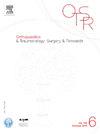No secondary osteoarthritis after recession wedge trochleoplasty associated with tibial tubercle osteotomy for treating recurrent patellar dislocation in high-grade dysplasia
IF 2.2
3区 医学
Q2 ORTHOPEDICS
引用次数: 0
Abstract
Purpose
To determine in the long-term the rate of osteoarthritis of recession wedge trochleoplasty performed in patients with high-grade trochlear dysplasia and recurrent patellar dislocations. The hypothesis was that the rate of secondary osteoarthritis was low.
Methods
Fifteen consecutive patients (17 knees) undergoing a recession wedge trochleoplasty surgery for recurrent patellar dislocation were retrospectively included. Recurrence of dislocation and functional scores of Lille and Kujala were collected. A complete radiological assessment was carried out to assess secondary patella-femoral and femoro-tibial osteoarthritis.
Results
No recurrence of dislocation was observed. Mean Lille and Kujala scores were respectively 84 ± 9/100 and 78 ± 12/100 at an average follow-up of 11.2 ± 1.8 years (132 ± 22 months, range 96–165).
No significant radiological changes in osteoarthritis were observed.
Of the 15 knees without any radiological signs of patellofemoral osteoarthritis at time of surgery, 7 presented a bone remodeling (Iwano1) and 8 had no signs of osteoarthritis at the latest follow-up. Among the 2 knees with a preoperative Iwano stage 1, one evolved to Iwano stage 2.
Conclusion
Recession wedge trochleoplasty is an effective treatment for recurrent patellar instability in patients with a high-grade trochlear dysplasia. In the long term, the patellofemoral joint is stable, the functional scores are good, and there is no significant arthritic degeneration.
Level of evidence
IV, retrospective series.
退行楔形滑车成形术联合胫骨结节截骨术治疗高度发育不良复发性髌骨脱位后无继发骨关节炎。
目的:确定高度滑车发育不良和复发性髌骨脱位患者行退退楔形滑车成形术后骨性关节炎的长期发生率。假设继发性骨关节炎的发病率很低。方法:回顾性分析15例(17膝)复发性髌骨脱位行退楔式滑车成形术的患者。收集脱位复发率及Lille和Kujala功能评分。进行完整的放射学评估以评估继发性髌骨-股骨骨关节炎和股胫骨关节炎。结果:无脱位复发。平均随访11.2±1.8年(132±22个月,范围96 ~ 165),平均Lille和Kujala评分分别为84±9/100和78±12/100。骨关节炎未见明显影像学改变。在手术时没有任何髌股骨关节炎影像学征象的15个膝关节中,7个出现骨重塑(iwano), 8个在最近随访时没有骨关节炎征象。术前为Iwano期1的2个膝关节中,1个发展为Iwano期2。结论:退行楔式滑车成形术是治疗高度滑车发育不良患者复发性髌骨不稳的有效方法。长期来看,髌股关节稳定,功能评分良好,无明显关节炎退变。证据等级:IV级,回顾性研究。
本文章由计算机程序翻译,如有差异,请以英文原文为准。
求助全文
约1分钟内获得全文
求助全文
来源期刊
CiteScore
5.10
自引率
26.10%
发文量
329
审稿时长
12.5 weeks
期刊介绍:
Orthopaedics & Traumatology: Surgery & Research (OTSR) publishes original scientific work in English related to all domains of orthopaedics. Original articles, Reviews, Technical notes and Concise follow-up of a former OTSR study are published in English in electronic form only and indexed in the main international databases.

 求助内容:
求助内容: 应助结果提醒方式:
应助结果提醒方式:


